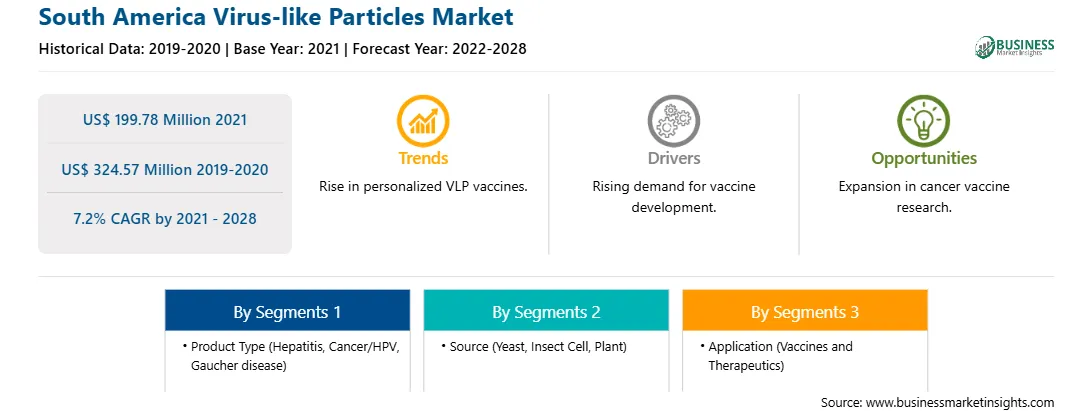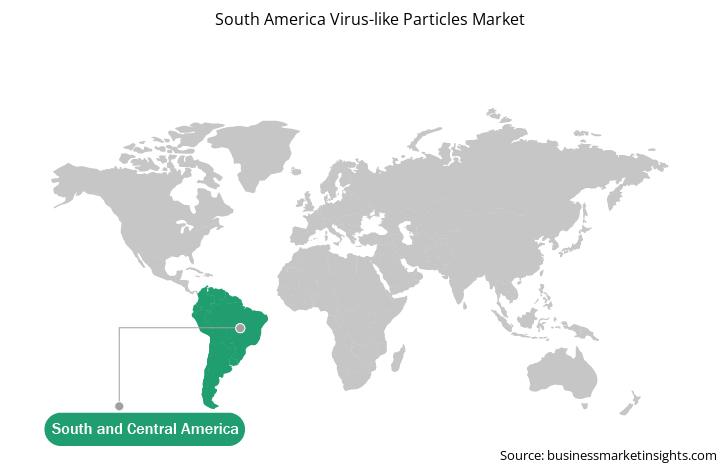Market Introduction
Major countries included as a part of analysis for South America includes Argentina, Brazil, and Rest of South America. The growth of the market for the virus-like particles in the region is attributed to the aging population, flourishing diagnostics market and growing initiatives of the major players in the pharmaceutical industry. The market is likely to propel in the forecasted period owing to the recent technological developments which have made a direct impact on the economy of Brazil that has advanced to a large extent. About 100,000 cases of acute hepatitis B virus (HBV) infection occur annually in South America. The overall prevalence of hepatitis B (HBV) infection in low risk populations ranges from 6.7% to 41%, while hepatitis B surface antigen (HBsAg) rates range from 0.4% to 13%. In high endemicity aboriginal or rural populations, perinatal transmission may play a major part in the spread of hepatitis B (HBV).
As South America becomes the new epicenter of COVID-19, fears are growing about depending on a vaccine designed and manufactured overseas, especially since wealthier countries have historically had better access to immunizations. Governments in South America acted quickly and preemptively to safeguard their citizens and control the spread of COVID-19 across the area, as well as its economic consequences. According to reports, certain governments in high-income countries have attempted to purchase vaccine-manufacturing companies or a portion of their supply. According to the researchers, they coat virus-like particles with pieces of the proteins that the coronavirus utilizes to enter human cells in the hopes of tricking the immune system into creating antibodies that will block the coronavirus during infection. Because these particles can't replicate inside the human body, and the virus-like particles regarded safer than vaccinations created from weakened viruses, and the technology has already been utilized to develop commercially accessible hepatitis B and human papillomavirus vaccines. Further, Argentina and Mexico inked an agreement with mAbxience, the British pharmaceutical company AstraZeneca, and Oxford University in August 2020. The goal is to create between 150 and 250 million doses of the COVID-19 vaccine, which will be distributed throughout South America is expected to help the region in its fight against the COVID-19.
Strategic insights for the South America Virus-like Particles provides data-driven analysis of the industry landscape, including current trends, key players, and regional nuances. These insights offer actionable recommendations, enabling readers to differentiate themselves from competitors by identifying untapped segments or developing unique value propositions. Leveraging data analytics, these insights help industry players anticipate the market shifts, whether investors, manufacturers, or other stakeholders. A future-oriented perspective is essential, helping stakeholders anticipate market shifts and position themselves for long-term success in this dynamic region. Ultimately, effective strategic insights empower readers to make informed decisions that drive profitability and achieve their business objectives within the market. The geographic scope of the South America Virus-like Particles refers to the specific areas in which a business operates and competes. Understanding local distinctions, such as diverse consumer preferences (e.g., demand for specific plug types or battery backup durations), varying economic conditions, and regulatory environments, is crucial for tailoring strategies to specific markets. Businesses can expand their reach by identifying underserved areas or adapting their offerings to meet local demands. A clear market focus allows for more effective resource allocation, targeted marketing campaigns, and better positioning against local competitors, ultimately driving growth in those targeted areas.South America Virus-like Particles Strategic Insights

South America Virus-like Particles Report Scope
Report Attribute
Details
Market size in 2021
US$ 199.78 Million
Market Size by 2028
US$ 324.57 Million
Global CAGR (2021 - 2028)
7.2%
Historical Data
2019-2020
Forecast period
2022-2028
Segments Covered
By Product Type
By Source
By Application
Regions and Countries Covered
South and Central America
Market leaders and key company profiles
South America Virus-like Particles Regional Insights

Market Overview and Dynamics
The virus-like particles market in South America is expected to grow from US$ 199.78 million in 2021 to US$ 324.57 million by 2028; it is estimated to grow at a CAGR of 7.2% from 2021 to 2028. Vaccines form one of the significant segments of the pharmaceuticals industry. They have an extensive application in the immunization of humans and animals against common infections. Companies operating in the pharmaceuticals and biopharmaceuticals markets continuously focus on product innovations and developments to sustain competition in the market. For instance, the market players have been significantly investing in the development of vaccines against COVID-19 and studies related to VLP. The active developments by life sciences companies, coupled with government support for the same, is contributing to the VLP market growth.
Key Market Segments
In terms of product type, the hepatitis segment accounted for the largest share of the South America virus-like particles market in 2021. In terms of source, the yeast segment accounted for the largest share of the South America virus-like particles market in 2021. In term of application, vaccines segment held a larger market share of the virus-like particles market in 2021.
Major Sources and Companies Listed
A few major primary and secondary sources referred to for preparing this report on the virus-like particles market in South America are company websites, annual reports, financial reports, national government documents, and statistical database, among others. Major companies listed in the report are Merck & Co., Inc.; GlaxoSmithKline plc.; Pfizer Inc.; Sanofi; Serum Institute of India Pvt. Ltd.; BHARAT BIOTECH; and LG Chem among others.
Reasons to buy report
South America Virus-like Particles Market Segmentation
South America Virus-like Particles Market – By Product type
South America Virus-like Particles Market – By Source
South America Virus-like Particles Market – By
Application
South America Virus-like Particles Market – By Country
South America Virus-like Particles Market – Companies Mentioned
The South America Virus-like Particles Market is valued at US$ 199.78 Million in 2021, it is projected to reach US$ 324.57 Million by 2028.
As per our report South America Virus-like Particles Market, the market size is valued at US$ 199.78 Million in 2021, projecting it to reach US$ 324.57 Million by 2028. This translates to a CAGR of approximately 7.2% during the forecast period.
The South America Virus-like Particles Market report typically cover these key segments-
The historic period, base year, and forecast period can vary slightly depending on the specific market research report. However, for the South America Virus-like Particles Market report:
The South America Virus-like Particles Market is populated by several key players, each contributing to its growth and innovation. Some of the major players include:
The South America Virus-like Particles Market report is valuable for diverse stakeholders, including:
Essentially, anyone involved in or considering involvement in the South America Virus-like Particles Market value chain can benefit from the information contained in a comprehensive market report.